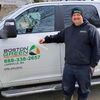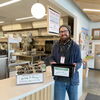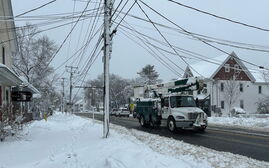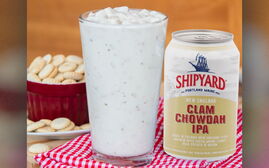Processing Your Payment
Please do not leave this page until complete. This can take a few moments.
Ski industry taps technology, diversifies to expand its $300M yearly impact
As folks who've shoveled a ton of snow from their driveways over the past month might predict, it's been a great winter so far for Maine's ski industry.
“It's a lot better than last year,” says Chet Homer, owner of the Shawnee Peak Ski Area in Bridgton. “But we're all counting on a particular week and we don't want to jinx ourselves.”
Reached prior to February's school break, Homer — like the superstitious theater buffs who avoid saying “Macbeth” — refused to say so but was referring to that break, one of the industry's biggest weeks.
Others were also happy.
“It's going very well, though 22 inches of new snow tends to have that effect,” says Darcy Lambert, director of communications for Sunday River Resort in Newry.
“It's been a good season, even better after last week,” says Ethan Austin, director of marketing and communications at Maine's largest ski area, Sugarloaf Mountain and Ski Resort.
“Everybody's pretty darn good,” says Portland-based Ski Maine Association Executive Director Greg Sweetser.
By mid-February, Sunday River was reporting 24 inches of new snowfall in just 24 hours, on top of 24 inches since February's start.
“This is hands-down the best February in terms of natural snowfall that Sunday River has seen in over a decade,” Lambert said in a press release.
Not every year has been so good
But this year's great snowfalls come after last year's nonexistent ones.
“It was a record warm year and nobody was open Christmas week,” recalls Homer. “When it became cold and we were able to make snow, we made snow like crazy. That's why you've always got to invest in snowmaking.”
Homer says he doesn't have an opinion in any debate about climate change.
“But the extremes between hot and cold seem to be more dramatic,” he says. “You can have a violent snowstorm or an extreme rainstorm or extreme heat. After the last three or four years, I don't know what a normal winter is anymore.”
That doesn't necessarily mean it's any more challenging to run the business these days.
“It's always challenging,” Homer says. “But I'm accustomed to it after 23 years. Weather-related businesses have to understand that you go with the ups and downs. You always have to put money back into it, whether you have a good year or a bad year. Fortunately, we're able to do that. It allows us to deal with the nuances that Mother Nature throws at us.”
The weather is clearly an important player for an industry that's integral to Maine's winter rural economy, says Sweetser.
“The economic impact is over $300 million,” Sweetser says. “The snowmobile industry is also over $300 million. So the two key components of rural tourism in Maine are over half a billion dollars.”
Those are direct-value numbers. The impact trends steeply upward, he says, when considering indirect value such as home purchases and property taxes paid by seasonal residents who ski.
“That's a good number,” he continues. “Summer crushes us, obviously: The Maine coast is one of the most unique parts of the world. But Maine in the winter, in the inland regions — those jobs are valuable.”
Ski visits have remained in the same range for many years, says Sweetser. In 2015, Maine saw 1.3 million visits, then 1.2 million in 2016.
“I feel pretty optimistic this year that we'll break 1.3 million,” he says. “The sense out there is that this year is average. It's not knocking off everybody's socks yet. But the blizzard [in early February] was the best advertising you can have. Everyone knows we have snow.”
“The weather is certainly the biggest factor in the business,” says Austin. “And if you don't have enough snow, it's whether you have cold-enough weather to make snow.”
That means keeping up with technology. The latest in snowmaking, says Austin, is low-energy snow guns that require less compressed air.
“Snowmaking is just water and air,” says Austin. “You put water and air through a pipe at very high pressure, and it shoots through a nozzle and creates snow.” The newest nozzles require less compressed air to make the same amount of snow. That means making more snow with the same amount of water and less energy.
“We've added about 750 of these guns over last seven or eight years,” says Austin. “They make up well over half of our snowmaking fleet. And we're continually updating our grooming fleet: The big thing is energy efficiency — using less fuel to groom for the same number of hours.”
At Shawnee Peak, snowmaking improvements include high-efficiency snow guns, hydrants and pumps to turn 50 million to 60 million gallons of water into snow per year, even in years of high amounts of natural snowfall.
“You're at the mercy of the weather, so you have to always invest in infrastructure, which is capital-intensive,” Homer says. “When it's cold out, you have to be ready to go. There's never a point when you can say, 'We're done.' You're never done. You have to have the infrastructure in place to optimize your snowmaking opportunities.”
Sunday River has invested over $7 million into its snowmaking infrastructure in the past decade, including energy-efficient snow guns. During snowmaking operations, the resort pumps up to 8,000 gallons per minute. Challenges include round-the-clock snowmaking at night and in the dark, with teams of employees positioning snow guns, unfreezing pipes and connecting and disconnecting hose in freezing temperatures.
At Ski Mount Abram, a small family resort in Greenwood, General Manager Dave Scanlan and his team serve a local, multi-generational base — up to 900 people on a busy winter day. Mount Abram also hosts summer events, including an annual music festival.
“We've got a really loyal following. We call them our 'village people,'” says Scanlan. “We see a lot of families coming out. We have music playing outside, and it's a really fun environment. What people take away most is the friendliness of our local contingency. It's akin to the old TV show 'Cheers.' Everyone knows everyone.”
But last year was an eye-opener for the industry, he says.
“It's a concern for all of us and it is driving innovation in snowmaking, and also people looking at offering four-season activities,” Scanlan says.
Mt. Abram innovations include solar-powered equipment. Installed in 2013 and partially funded by the USDA Rural Energy For America Program, the system provides 75% of the electricity required to operate the resort. And the mountain utilizes new Airless Snowguns, partially funded by a grant from Efficiency Maine, to improve efficiency, reducing air consumption by 50% and allowing a carbon offset of 402,804 pounds.
While it's not expected that Maine will lose its winters anytime soon, climate change is happening, Sweetser says, and technology is key.
“We'll be able to provide our product for decades to come through all of this adaptation,” Sweetser says. “But we're also working on diversifying our business, trying to become more year-round.”
Ski areas agree: Diversification is key
“We've been working to make ourselves more of a year-round business for many years,” says Austin. That includes a premiere golf club and numerous events throughout the summer. The Sugarloaf Marathon last May drew 1,600 runners. Last summer, the resort launched a variety of new events, including a summer concert series, trail race and mountain bike festival.
“Mountain biking up here as become a big activity,” says Austin. “We're seeing lots of growth in the mountain biking scene. And the core wedding and conference business do well for us. But they're still a small portion of the business compared to the ski side of things.”
Sugarloaf hosts major competitions such as this year's U.S. Alpine Championship. It also hosts a reggae-ski festival, drawing 7,000 to 9,000 people annually and generating revenue from retail, lodging, food and beverage.
“Lift ticket sales are our biggest money-makers, but lodging and food and beverage are big, too,” says Austin. “There's a pretty wide variety of things that make up the entire portfolio.”
Sunday River similarly has a year-round schedule. Recently, says Lambert, the resort added night skiing, coupled with live entertainment, fireworks, tubing — the works, to create a vibrant atmosphere. Skier numbers remain fairly steady, but Sunday River is seeing a bit of an upward trend in summer business, largely attributable to increased group business in the past few years, such as the 10-week Gordon Research Conference, filling its hotels. The wedding business has grown by 25% per year over the last few years. A partnership with L.L.Bean Outdoor Discovery School brings customers for summer activities. Mountain biking, hiking, disk golf — the course expanded last summer, zip line tours and scenic gondola rides provide additional business.
“We've offered summer activities for over a decade but certainly have added to it,” says Lambert. “The 'Chondola' lift has really helped turn around activities in terms of who we're able to transport up to the top of the mountain, how we're able to utilize the mountain peak lodge both for winter visits and weddings and conferences and guest activities and events in the summer and fall. So that's helped us grow the summer portion of the business.”
“If we could build our summer business so it could match winter, that would be perfect, because employment would be much more stable,” Sweetser says. “One of the challenges that Maine mountains face is our incredible coastline. In Vermont, the mountains are the number one tourism driver winter and summer.” In Maine, the coast is the summer draw. “So that's an obstacle unique to Maine.”
















Comments